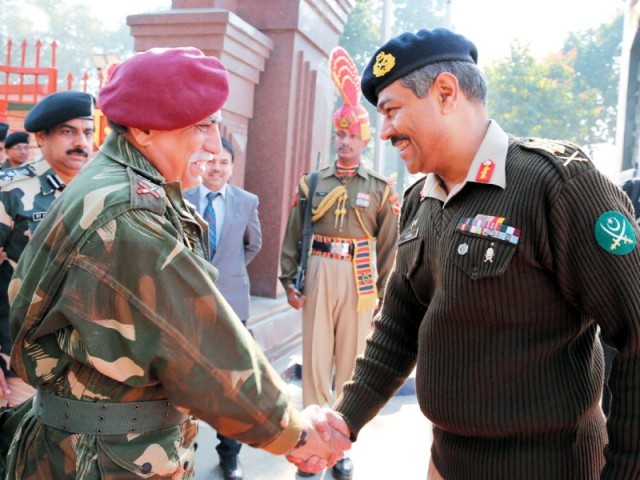
Year 2013 is officially over, and with that surfaces the hope that the next year may prove to be less adventurous and more “peace” productive between India and Pakistan. Somewhat like Friday the 13th, the concluding year had very little good news for South Asians, in particular the nuclear neighbors. Amongst the few positives, one could top slot elections that took place in Pakistan, followed by Maldives and Nepal, initiation of electioneering in India and Afghanistan, some civil society activism in nearly all the South Asian capitals, but none even come close to pale the Arab spring. Last but not least, the meeting of Pakistani and Indian prime ministers in New York in September this year led to a slight push towards normalcy.
If nothing else, India and Pakistan have no dearth of issues to disagree and dispute over. As of early January, the already fragile and precariously balanced “peace,” suffered yet another major setback when the Line of Control (LoC) alongside Jammu and Kashmir area became restive enough to make the continuity of bilateral dialogue once again dubious and conditional. A ceasefire alongside the LoC, had been upheld for the past decade, after being unilaterally declared by Pakistan under general Musharraf in November 2003, and for once reciprocated affirmatively by New Delhi. The ten supposed golden years of ceasefire along what the divided Kashmiri population calls the “khoni lakir” were not ideally without violations or occasional exchange of fire. However, this time period where positively witnessed opening up of cross-LoC trade and transport linkages as of 2007, New Delhi in 2004 happily announced that the completion of 550 km of fence covering most of the 740 km LoC, had most successfully brought down the “infiltration” rate to 20%. The fence alongside the disputed land stretch was of course considered not only as a violation of mutual accords, but also a breach of the fragile trust and confidence that was being carefully crafted. A neutral analysis could have brought about a slightly altered perspective, one in which post 9/11 most of such forces were occupied in another proxy duel, and a Kashmiri population which virtually each summer vehemently voiced its purely indigenous protest against occupation forces and genuine grievances. In fact concerned voices both from Kashmir and New Delhi would highlight the plight but without much effect.
The year-long skirmishes across the LoC initiated when around January 9th, both sides claimed infiltration and then killing of soldiers. What could have been a small scale manageable issue, very soon turned into not only a media circus driven by target rating points but also an opportunity for political point scoring, with accusations and counter accusations heralded back and forth. Unfortunately any voices of sanity or rationality were downed by the Indian sales pitch as the country was entering the election year, with incumbent government already on a weak political footing, and the Indian military now ran the Pakistan policy. As for Pakistan, ironically enough, despite being in the thick of elections, conflict with India was never high on the campaign agenda, rather PML-N, which later won the elections, went all out to sound a reconciliatory tone with its neighbor, facing scathing criticism when an incarcerated Pakistani was killed in retaliation to Sarabjit Singh’s killing in Pakistan.
The result unfortunately was as predicted, once again whatever the shape of the peace process, it came grinding to a halt and made future continuity conditional. Any gesture towards normalcy or reconciliation was discouraged and dismissed as a sign of weakness and losing ground, the “other” side was demonized and portrayed as barbaric, even to the point that the two prime ministers almost did not meet, because of the heavy negative sentiment. This all happened at a time, when both the nuclear neighbors, have methods, protocols and institutional infrastructure well laid out to defuse and mitigate such disputes. The 1972 Hotline agreement between the director general military operations being one of the longest standing protocols in this regard. This was later strengthened further when a similar link was established between the foreign and external affairs ministries of Pakistan and India respectively.
The DGMO hotline and flagship meetings ought to be routine and procedural than a major headline, as happened in the case of December 24th meeting. Which interestingly, took place after fourteen long years!! Immediately after January firings, a suggestion by Pakistan to involve the UNMOGIP as an established neutral monitor could have also been effectively taken up. Such incidents reflect the fragility of the peace process, it shows how emotional rhetoric and political jingoism, spoilers and interest groups, benefit more from the continuation of conflict than peace. So long as this trend continues, development and progress will remain hostage and elusive and the consequences would be for the people of the two countries and the region to face. The DGMO meeting, concluded on a positive note, later to be augmented by a five day meeting of Indian and Pakistan (border) security forces, which brought up the issue of joint patrolling in order to thwart drug smuggling besides an understanding to send back inadvertent border crossers, and check illegal construction. One can only hope that these meetings pave the path for a positive start to the New Year. January 1st, like many before it, started with a ritualistic exchange of documents enlisting nuclear installations both countries have, and beyond this, there is little doubt anything substantial will happen. Though one can harbor the wishful thought that in our life time the khoni lakir will turn into a “line of peace,” and for that we need to rise above the obvious, incentivize peace and work for the common good of humanity than remain hostage to narrow nationalist thoughts.
***
Image: Pakistan Inter Services Public Relations (ISPR), Getty